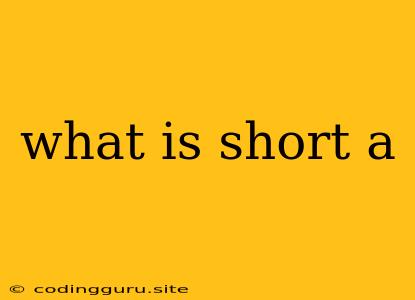What is a Short Sell?
In the world of finance, short selling is a strategy where investors borrow an asset (like a stock) and immediately sell it in the market, hoping to buy it back later at a lower price. The difference between the selling price and the buying price (after buying it back) is their profit. But, what exactly is a short sell and how does it work?
Think of it like this: you borrow a friend's expensive jacket and sell it to someone else. You hope to buy it back at a cheaper price later, keeping the price difference for yourself. If the jacket's price drops, you profit. But if the price rises, you're left with a loss.
How does a Short Sell Work?
Short selling involves a few key steps:
- Borrowing the asset: Investors need to borrow the asset (like a stock) from a broker or another lender.
- Selling the asset: The borrowed asset is then sold in the market.
- Buying the asset back: Later, when the price drops, the investor buys the asset back to return it to the lender.
- Profit or loss: The difference between the initial selling price and the final buying price determines the profit or loss.
Why Short Sell?
Short selling is a complex strategy, but it can be used for various reasons:
- Profiting from a declining market: If an investor believes the price of an asset will fall, they can short sell it and benefit from the price drop.
- Hedging against losses: Short selling can be used to offset potential losses in a long position (owning an asset).
- Speculation: Some investors engage in short selling to speculate on market movements, hoping to generate profits.
Risks of Short Selling
Short selling is a high-risk strategy. Here are some key risks:
- Unlimited losses: Unlike long positions, short selling has the potential for unlimited losses. If the price of the asset rises instead of falling, the losses can keep accumulating.
- Margin calls: Brokers often require investors to deposit a margin (cash or securities) as collateral against potential losses. If the price rises, the margin account may need to be topped up with additional funds.
- Short squeeze: When many investors try to buy back a shorted asset at the same time, it can drive the price up rapidly, creating a short squeeze and forcing short sellers to cover their positions at a significant loss.
Example of Short Selling
Let's say you believe the price of Apple stock will decline from $150 to $100. You borrow 100 shares of Apple stock from a broker and sell them in the market at $150 per share. This earns you $15,000 (100 shares x $150).
Later, when the price drops to $100, you buy 100 shares of Apple stock to return to the broker. This costs you $10,000 (100 shares x $100).
You made a profit of $5,000 (selling price - buying price), or $50 per share ($150 - $100).
Conclusion
Short selling is a powerful strategy that allows investors to profit from declining market prices. However, it's essential to understand the risks associated with short selling, such as unlimited losses, margin calls, and short squeezes. Before engaging in short selling, it's crucial to conduct thorough research, understand the market dynamics, and have a well-defined strategy to manage potential losses.
